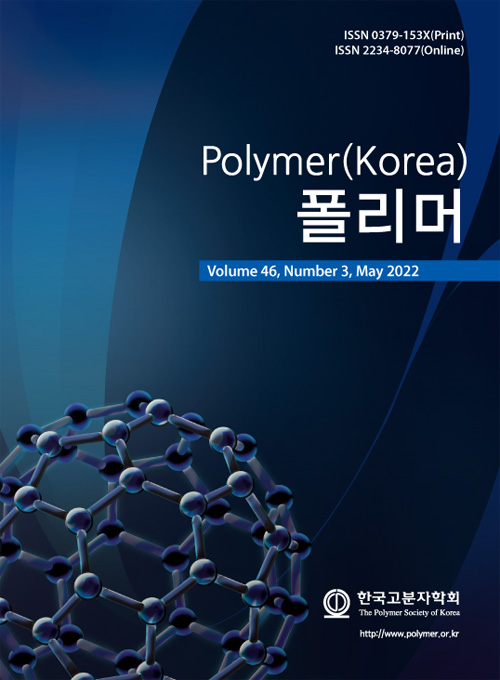- Biodegradation of Aliphatic Polyesters Under Composting and Seawater Conditions
Yujin Hyun*, Hyo Won Kwak**, ***,†
 , and Hyoung-Joon Jin*, ****,†
, and Hyoung-Joon Jin*, ****,†
*Program in Environmental and Polymer Engineering, Inha University, Incheon 22212, Korea
**Department of Agriculture, Forestry and Bioresources, Seoul National University, 1 Gwanak-ro, Gwanak-gu, Seoul 08826, Korea
***Research Institute of Agriculture and Life Sciences, Seoul National University, 1 Gwanak-ro, Gwanak-gu, Seoul 08826, Korea
****Department of Polymer Science and Engineering, Inha University, Incheon 22212, Korea- 생분해성 지방족 폴리에스테르의 퇴비 및 해수 환경 생분해도 평가
*인하대학교 고분자환경융합공학전공, **서울대학교 농림생물자원학부, ***서울대학교 농업생명과학연구원, ****인하대학교 고분자공학과
Reproduction, stored in a retrieval system, or transmitted in any form of any part of this publication is permitted only by written permission from the Polymer Society of Korea.
To determine the optimal evaluation method for the degradation of poly(butylene succinate) copolymer (PBS-c) under seawater conditions, biodegradability under composting conditions was determined according to ISO 14855-2, the most general biodegradation test method for composting conditions, and the results were compared with those obtained under seawater conditions. Under composting conditions, after 45 days, the biodegradation of PBS-c reached 57% and the weight average molecular weight of PBS-c decreased from the initial 153000 g/mol to 44000 g/mol. Meanwhile, under seawater conditions, the weight average molecular weight of PBS-c decreased to 94000 g/mol after 34 weeks. Although no significant changes in the chemical and crystal structure of PBS-c were observed after 34 weeks in seawater, the surface of the sample became rougher, as observed using scanning electron microscopy. The significantly slower biodegradation occurring under seawater conditions than under composting conditions can be attributed to the lower concentration of microorganisms in seawater at the lower test temperature. Therefore, a PBS-c degradation test was performed under accelerated conditions in seawater. Under accelerated conditions, the weight average molecular weight of PBS-c deceased to 29000 g/mol and substantial cracking and damage occurred on the surface of the PBS-c sample as a result of degradation.
본 연구에서는 해수에서 진행된 poly(butylene succinate) copolymer(PBS-c) 생분해도 측정 결과의 신뢰성 확인을 위해, 일반적 퇴비화 조건인 ISO 14855-2 평가법에 따라 생분해도를 측정하였으며 그 결과를 비교하였다. 퇴비화 조건에서는 측정 시작 45일 이후 PBS-c의 생분해도는 57%로 나타났으며, PBS-c의 무게 평균 분자량은 초기 153000 g/mol에서 44000 g/mol로 감소하였다. 한편 해수 조건에서 PBS-c의 무게 평균 분자량은 분해 34주차에 94000 g/mol로 감소하였다. 34주 동안 PBS-c의 화학 구조 및 결정 구조에는 큰 변화가 나타나지 않았지만, 분해가 진행될수록 시료 표면의 거칠기가 다소 증가하였다. 해수 조건에서 진행된 생분해도의 경우 퇴비화 조건 보다 긴 분해 기간에도 불구하고 분해도가 낮게 나타났으며, 이는 해수에 존재하는 미생물의 농도와 측정 온도가 낮기 때문에 나타나는 현상으로 사료된다. 따라서 해수 가속화 조건으로 진행하였을 때 PBS-c의 무게 평균 분자량은 29000 g/mol까지 감소하였으며 시료의 표면에서 크랙 및 시료 손실이 크게 발생하였다. 이를 통해 해수에서도 가속화 조건으로 진행했을 때, 퇴비화 조건과 비슷한 생분해도를 갖는 것을 확인하였다.
Keywords: biodegradation, aliphatic polyesters, seawater, compost, poly(butylene succinate).
- Polymer(Korea) 폴리머
- Frequency : Bimonthly(odd)
ISSN 0379-153X(Print)
ISSN 2234-8077(Online)
Abbr. Polym. Korea - 2023 Impact Factor : 0.4
- Indexed in SCIE
 This Article
This Article
-
2022; 46(3): 318-326
Published online May 25, 2022
- 10.7317/pk.2022.46.3.318
- Received on Aug 10, 2021
- Revised on Nov 12, 2021
- Accepted on Nov 12, 2021
 Correspondence to
Correspondence to
- Hyo Won Kwak**, ***, and Hyoung-Joon Jin*, ****
-
*Program in Environmental and Polymer Engineering, Inha University, Incheon 22212, Korea
**Department of Agriculture, Forestry and Bioresources, Seoul National University, 1 Gwanak-ro, Gwanak-gu, Seoul 08826, Korea
***Research Institute of Agriculture and Life Sciences, Seoul National University, 1 Gwanak-ro, Gwanak-gu, Seoul 08826, Korea
****Department of Polymer Science and Engineering, Inha University, Incheon 22212, Korea - E-mail: bk0502@snu.ac.kr. hjjin@inha.ack.kr








 Copyright(c) The Polymer Society of Korea. All right reserved.
Copyright(c) The Polymer Society of Korea. All right reserved.